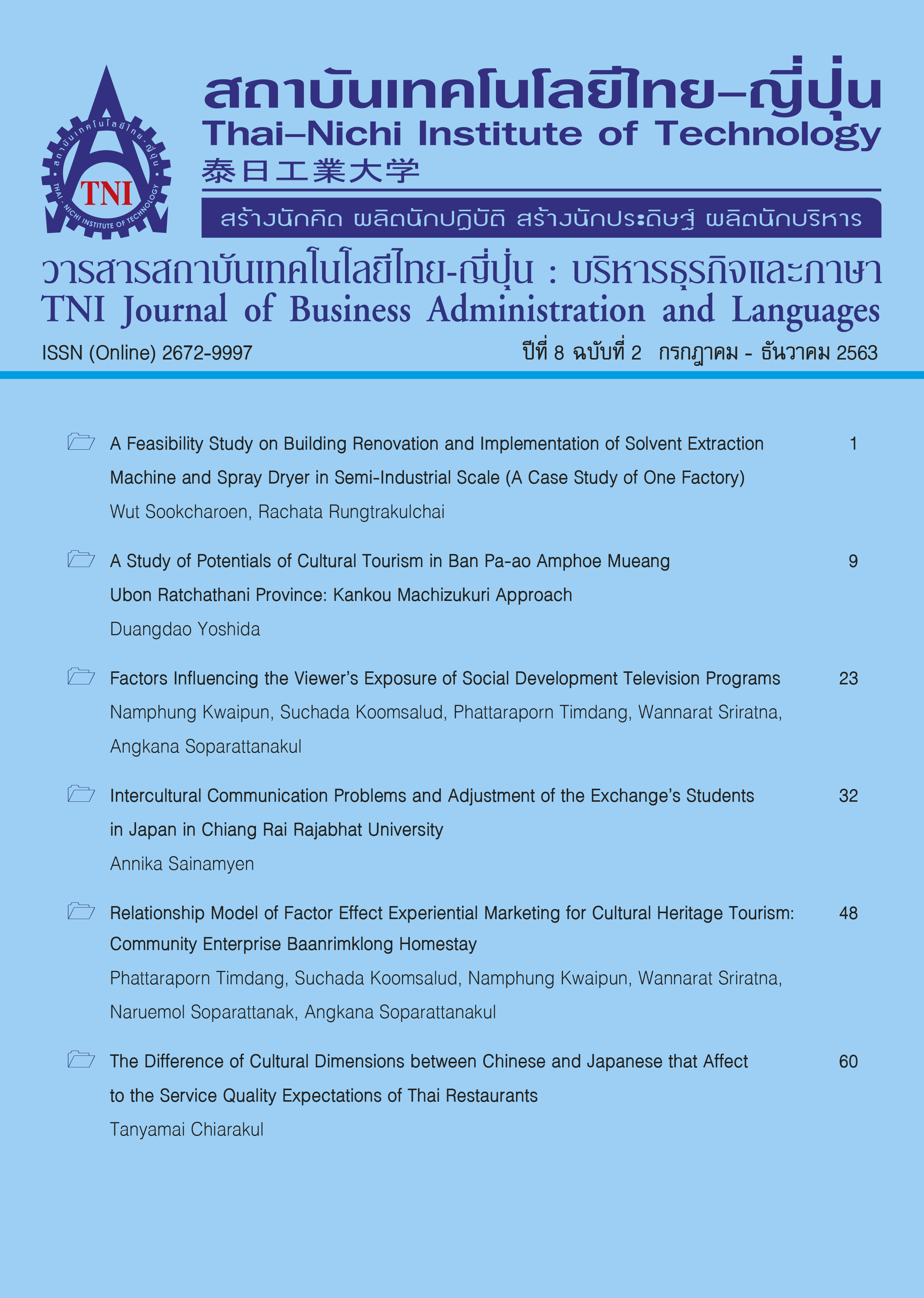The Difference of Cultural Dimensions between Chinese and Japanese that Affect to the Service Quality Expectations of Thai Restaurants
Main Article Content
Abstract
This research focused on (1) studying culture factors of Chinese and Japanese customers affecting to service quality expectations of Thai restaurants (2) studying guidelines of service quality development of Thai restaurants which were implemented in the countries with diverse cultures. The research combined both quantitative and qualitative methodologies. A questionnaire was distributed among a convenience sample of 300 Chinese customers and 300 Japanese customers. Further, an in-depth interview is carried out with two Chinese customers and two Japanese customers. In addition to descriptive statistics such as frequency, percentage, mean, standard deviation and relationship tests such as t-test and multiple regression were used for data analysis. The research found that Chinese customers gave the highest priority to MAS, and Japanese’s highest priority was PDI from cultural dimension perspective. With respect to the service quality expectation, the most Chinese customers perceived the reliability. However, majority of Japanese customers perceived Tangibility as the most importance quality. Interestingly, it is found that both Japanese and Chinese perceived Empathy as the lowest quality expectation. Further, it was found that Chinese customers perceived that dimensions of MAS, UAI and LTO as variables that significantly influence on service quality expectation whereas Japanese customers perceived that PDI, MAS, UAI and LTO were the variables that influence service quality expectations significantly. The same findings of quantitative analyses are supported by the results of Qualitative tests carried out.
Article Details
Article Accepting Policy
The editorial board of Thai-Nichi Institute of Technology is pleased to receive articles from lecturers and experts in the fields of business administration, languages, engineering and technology written in Thai or English. The academic work submitted for publication must not be published in any other publication before and must not be under consideration of other journal submissions. Therefore, those interested in participating in the dissemination of work and knowledge can submit their article to the editorial board for further submission to the screening committee to consider publishing in the journal. The articles that can be published include solely research articles. Interested persons can prepare their articles by reviewing recommendations for article authors.
Copyright infringement is solely the responsibility of the author(s) of the article. Articles that have been published must be screened and reviewed for quality from qualified experts approved by the editorial board.
The text that appears within each article published in this research journal is a personal opinion of each author, nothing related to Thai-Nichi Institute of Technology, and other faculty members in the institution in any way. Responsibilities and accuracy for the content of each article are owned by each author. If there is any mistake, each author will be responsible for his/her own article(s).
The editorial board reserves the right not to bring any content, views or comments of articles in the Journal of Thai-Nichi Institute of Technology to publish before receiving permission from the authorized author(s) in writing. The published work is the copyright of the Journal of Thai-Nichi Institute of Technology.
References
Dash, S., Bruning, E. and Acharya, M. (2009). International Journal of Bank Marketing, 27(5), 336-358.
Furrer, O., Liu, B. and Sudharshan, D. (2000). The relationship between culture and service quality perception: Basis for cross-cultural market segmentation and resource allocation. Journal of Service Research, 2(4), 355-371.
Hair, J.F. Black, W.C. Babin, B.J. Anderson R.E. and Tatham, R.L. (2006). Multivariate Data Analysis (6th ed.). New Jersey: Prentice Hall.
Hair, J. F., Black, W. C., Babin, B. J. & Anderson, R. E. (2010). Multivariate Data Analysis (7th ed.). Upper Saddle River, New Jersey: Prentice Hall.
Hoffmann, S., Mai, R. and Cristescu, A. (2013). Do culture-dependent response styles distort substantial relationships? International Business Review, 22(5), 814-827.
Hofstede, G. and Hofstede, G.J. (2005). Cultures and organizations: Software of the mind. Revised and expanded (2nd ed.). New York: McGraw-Hill.
Hofstede, G.H. (1980). Culture’s consequences: International differences in work-related values. Beverly Hills, CA: Sage.
Kausch, C. (2013). Attitudes toward corporate sustainability: a multi-item scale and a multi-country empirical analysis (dissertation Otto-von-Guericke-Universität Magdeburg). Retrieved from https://d-nb.info/1054135940/34
Kueh, K. and Voon, B.H. (2007). Culture and service quality expectations: Evidence from Generation Y consumers in Malaysia. Managing Service Quality: An International Journal, 17(6), 656-680.
Luximon A., Chan P. Y. (2017). Service quality expectation and cultural diversity in fast fashion retailing. Journal of Textile Engineering & Fashion Technology. 1(3), 93-99.
Marković, S. Raspor, S. and Dorčić, J. (2011). What are the key dimensions of restaurant service quality? An empirical study in the city restaurant settings. In Proceedings of Sustainable Tourism: Socio-Cultural Environmental and Economic Impact. (pp.235-249). Croatia: University of Rijeka.
Parasuraman A., Zheitmal V.A. and Berry L.L. (1998). SERVQUAL: a multiple item scale for measuring consumer perceptions of service quality. Journal of Retailing, 64(1), 12-40.
Rao, B. and Kunja, S.R. (2019). Individual cultural orientation as a determinant of psychological contract fulfilment. Management Research Review, 42(12), 1315-1332.
Thansettakij. (2015). Thai food is internationally recognized...business opportunities related to supply chain. (in Thai). Retrieved from http://www.thansettakij.com/content/106250
The Ninh Nguyen, Tuan Khanh Cao & Thi Thu Hoai Phan. (2015). Cultural Influences on Overall Service Quality Expectations: Evidence from Vietnamese Customers. Asian Social Science, 11(25), 151-159.


